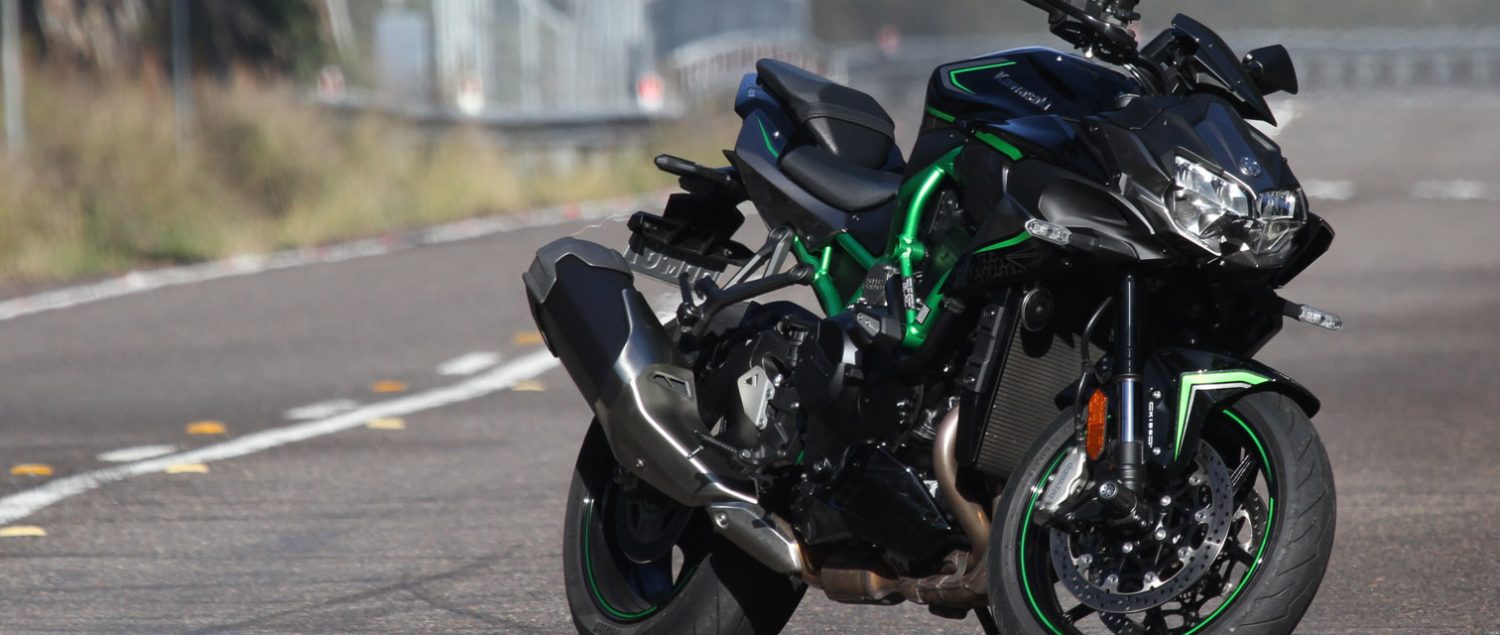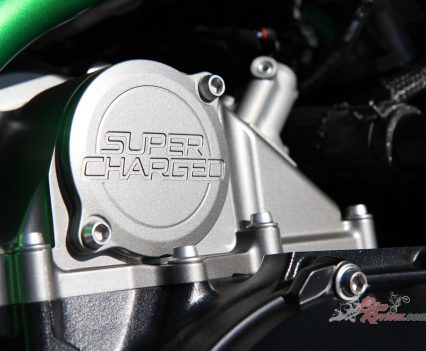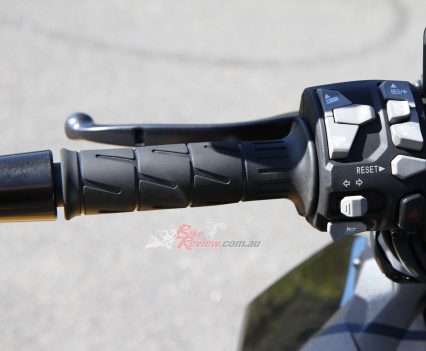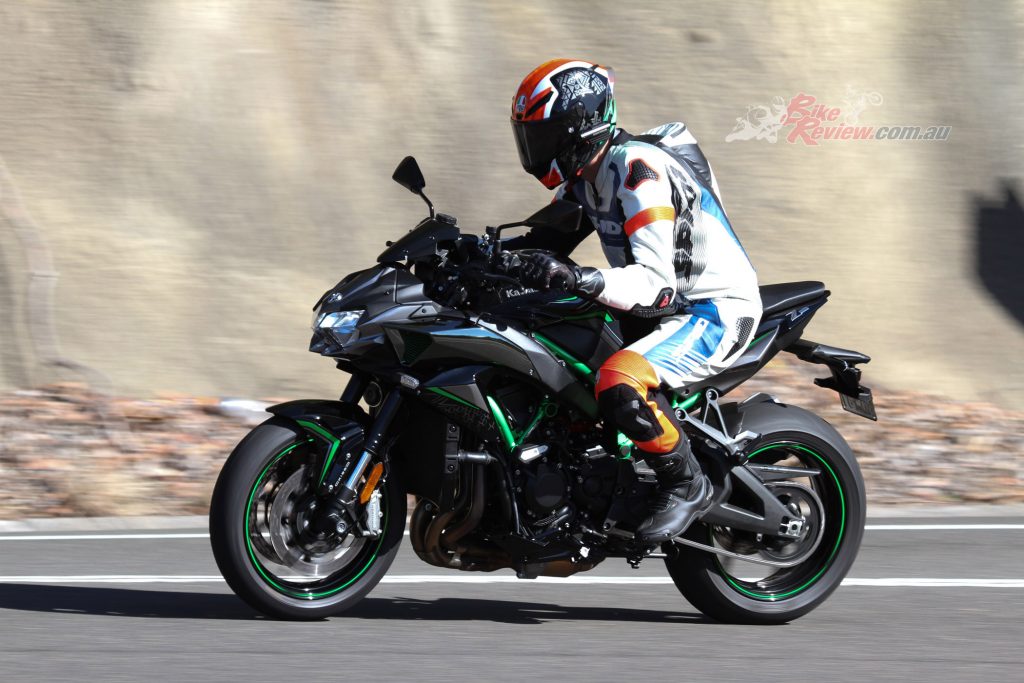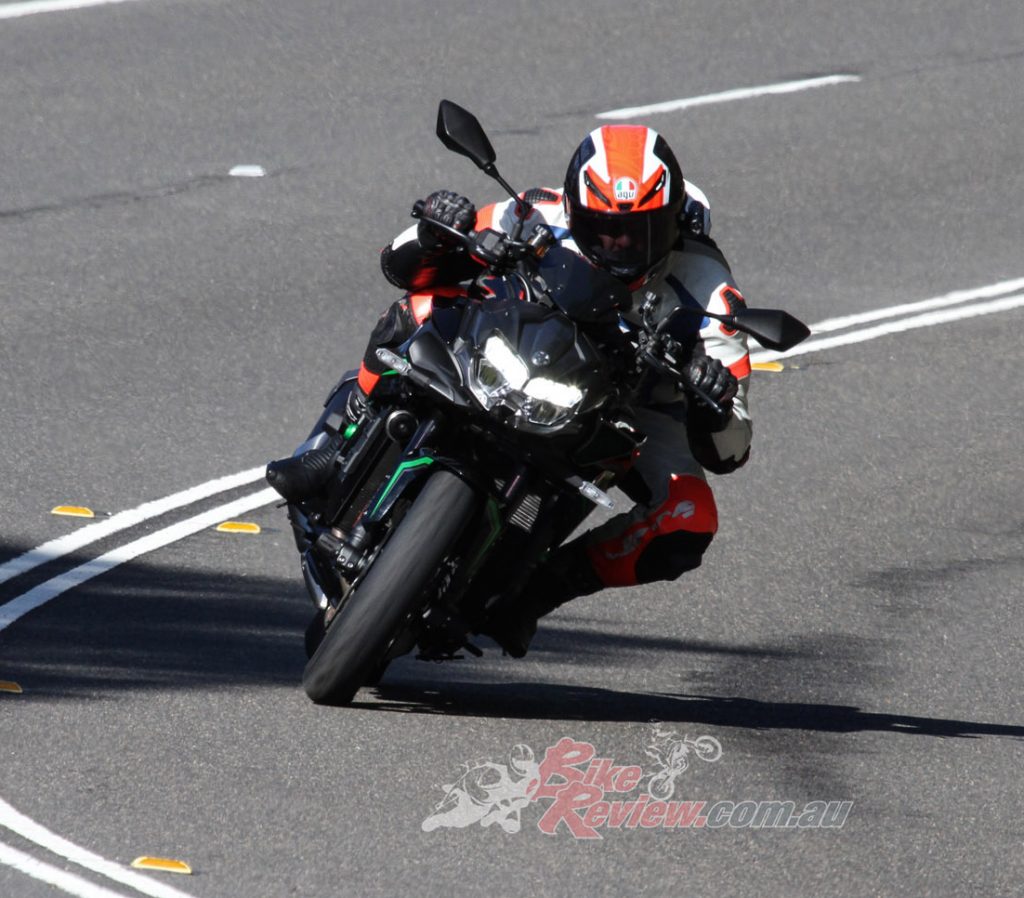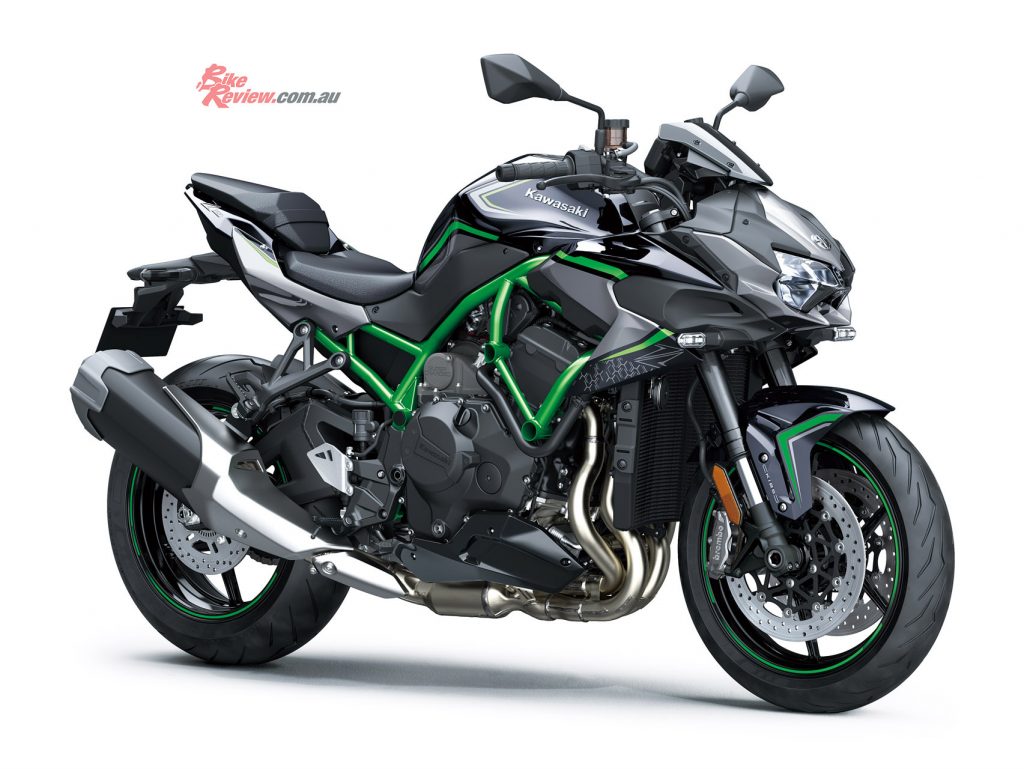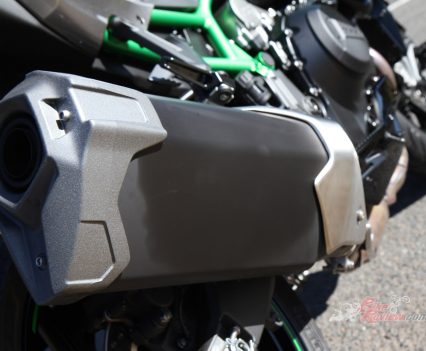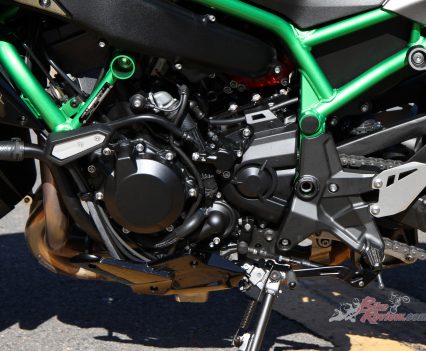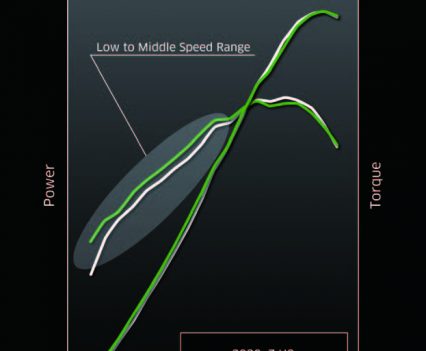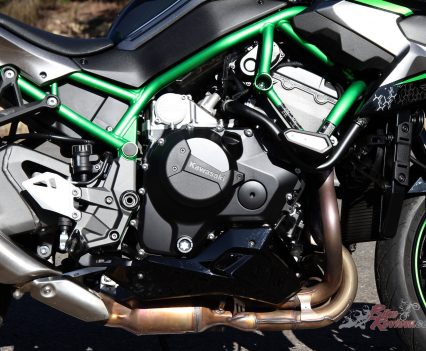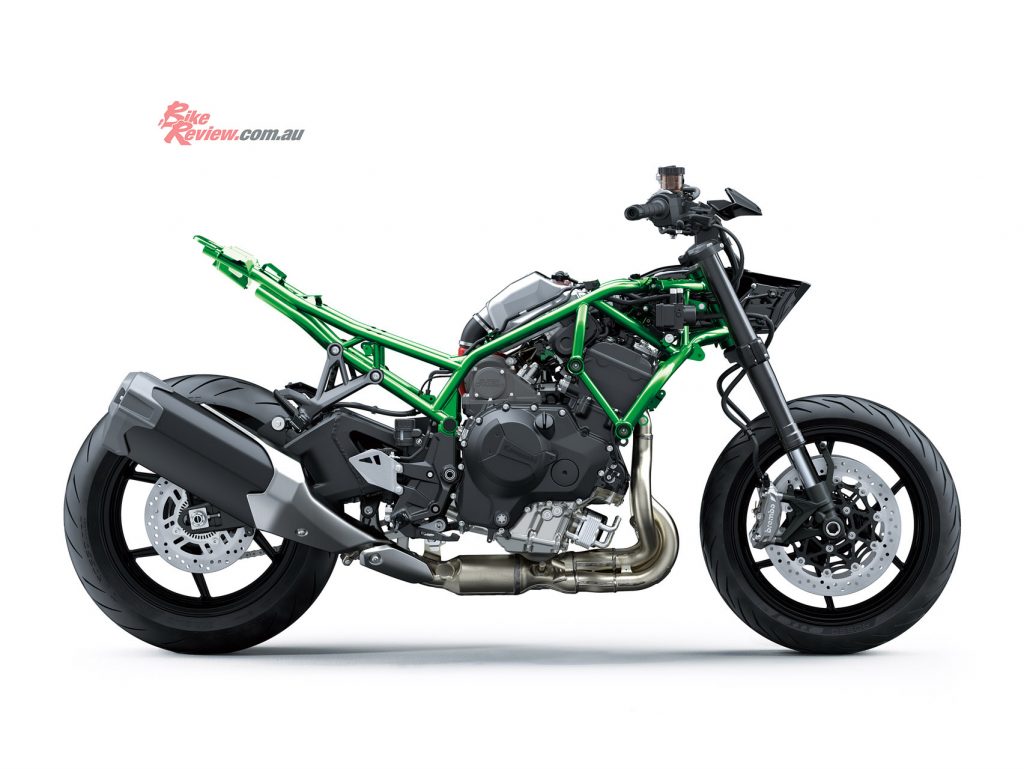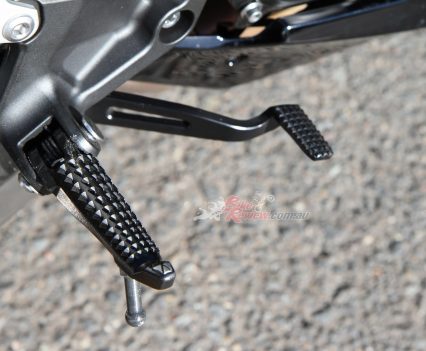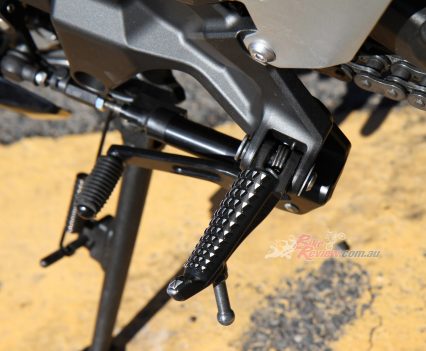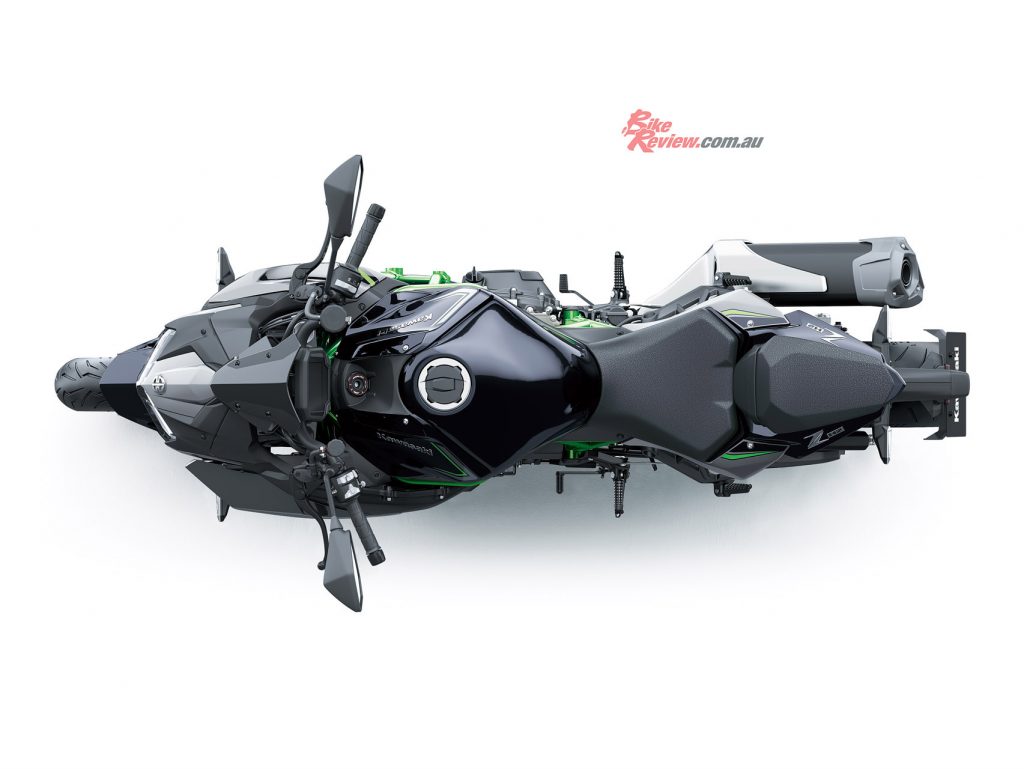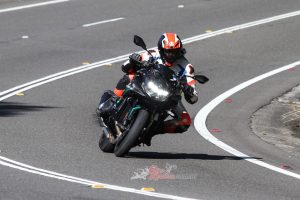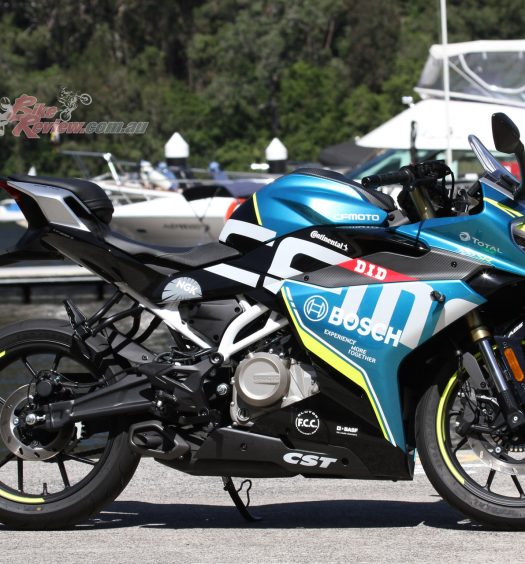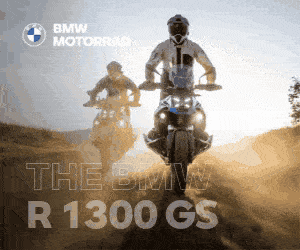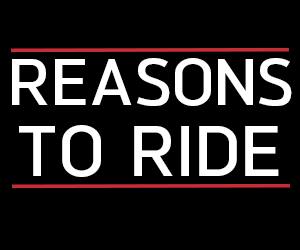The Kawasaki ZH2 is the wildest nakedbike to ever come out of Japan. We spent a week putting it to the test and managed to keep our licences... Review: Jeff Ware Photography: HMC Photography
Where was this beast when Rapid Bikes was around? It’s a question I asked myself as the Z H2 wheelstood over a small railway bridge just up the road from Kawasaki. It was another accidental mono, just like the one over the crest earlier. Take my money!
The Z H2 has to be one of the most talked about and eagerly anticipated bikes of the decade. The H2 stirred the entire motorcycle community up and there was talk and speculation of a naked version right from the start. Well, Kawasaki have done it, building a special chassis just for the naked version, including using a conventional double-sided swingarm, which looks like it could be off the ZX-10R.
Team Green have done this while managing to keep the price extremely competitive. It’s a high spec, high tech bike but one area was skimped on – the rear suspension, a basic two-way adjustable unit. So, how badly does that effect the overall performance of the Z H2? Read on and find out…

Every single motorcyclist should experience this bike at least once in their life. Twenty three grand is amazing value.
“The dash is the same as our other TFT units, so you will be familiar with that and the RIDEOLOGY connectivity,” grinned Kawasaki’s Ryan Murden, “The Riding Modes are Sport, Road, Rain, Rider. Cruise is here, it has Launch Control and KCMF, which is a cornering management function. Suspension is set to standard, tyre pressures standard, it’s all ready to go. “Oh and Jeff, no wheelies, no burnouts, you know the deal,” Ryan added with a smile, “By the way, I’ve set Rider Mode to full power, no traction control”…
I have a good walk around and look over the bike. It’s bigger than I thought it would be in the flesh. It’s not B-King big but it is huge for a 1000. The steering-head sits high and the fuel tank is tall. The fairing is bulky due to the air intake. The top of the tank is well above my waist height and I’m 187cm tall. The frontal area is really wide, yet the handlebars are narrow for a nakedbike. It’s unique…
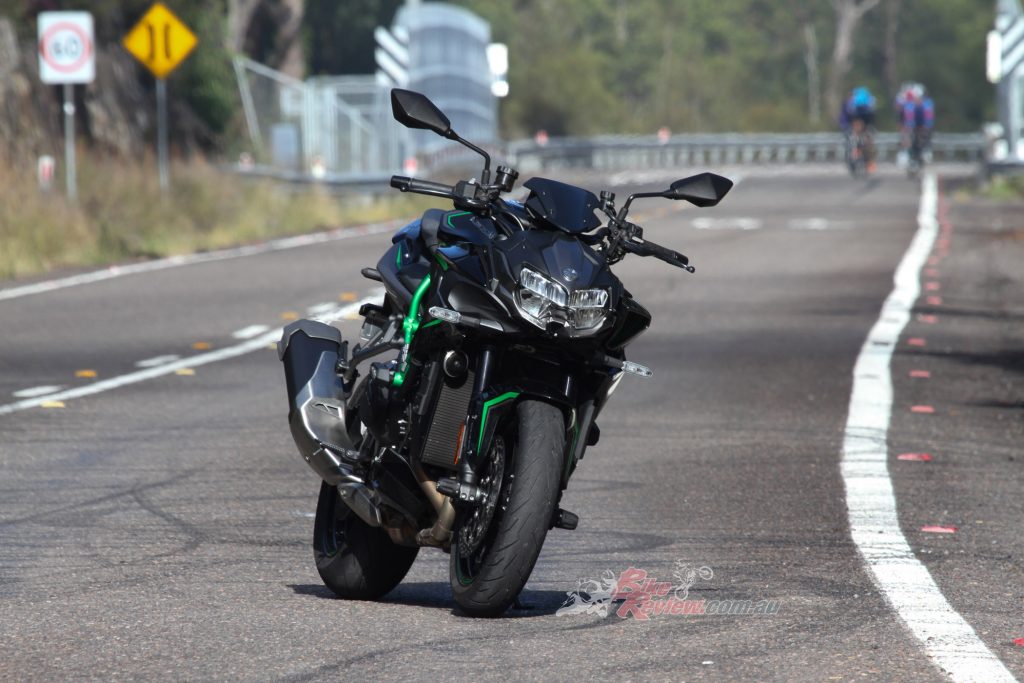
A tall tank, wide frontal area and fairly narrow ‘bars make the Z H2 quite a unique bike ergonomically.
I hop on and have a quick scroll through the dash then fire the beast into life. I’ve already done lots of riding on the Ninja H2 on the street, racetrack and drag strip. I’ve also put a lot of miles down on the H2 SX SE, so I’m familiar with the powerplant, as well as many custom turbo bikes I’ve ridden over the years. However, this Z H2, it’s somehow more exciting as it settles into a fast, raspy idle. It sounds like an angry superbike.
My heart is speeding up and no wonder. The Z H2 has the same horsepower and more torque than the Ninja H2 and more power and just under the torque of the stump pulling SX SE. It is 21kg lighter than the SX and just a kilo more than the Ninja. Impressive. Still, 239kg is a lot of motorcycle.
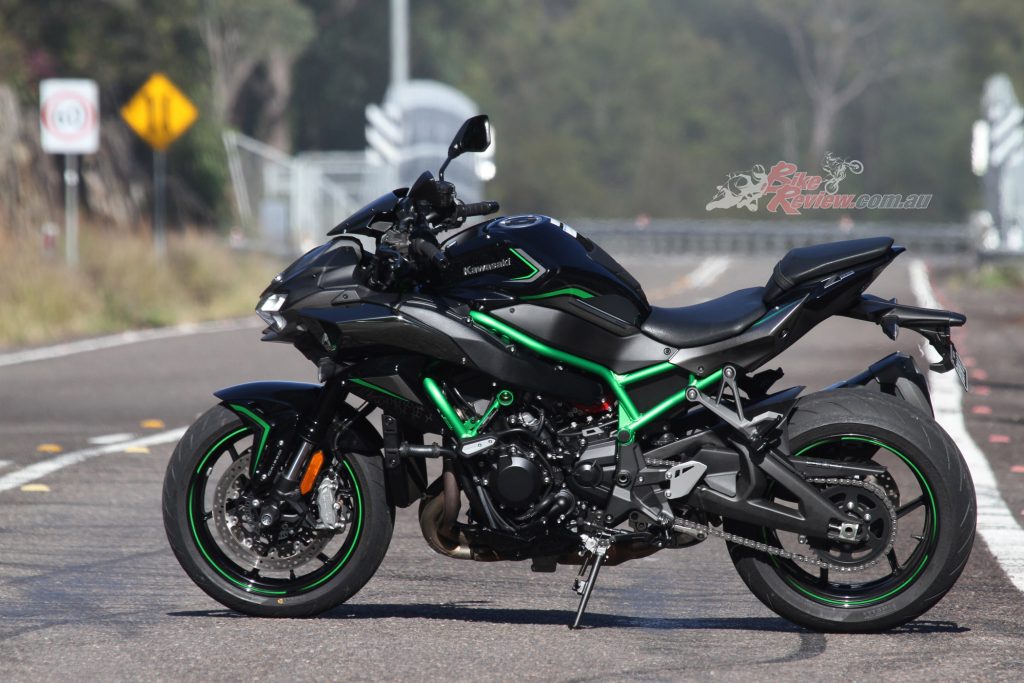
The Z H2 is 239kg/200hp/101ft-bs. The SX SE is 260kg/97hp/102ft-bs and the Ninja H2 138kg/200hp/98ft-lbs.,
I leave the Z in Rider Mode and roll out of TKA for the trip back up the coast. It’s COVID-19 restriction period so the law says you can only ride for work or essential reasons. Luckily it’s work. It means there are hardly any vehicles on the road, very surreal. I feel like I’m in some futuristic sci fi movie, blasting through deserted streets on a supercharged motorcycle. I’m loving it. It’s a crisp July day and I’ve got a red supercharger to keep me warm.
I’m not five minutes from Team Green HQ and I’ve already made my mind up that after COVID-19 pisses off, I’m putting some cash down on one of these beasts. It’s just so different. So much fun. I have to own one at least once in my lifetime. Might have to get hold of that early superannuation access. I’m sure Heather will be impressed… “It’s just a long term press bike, honey”… dream on.
The power and the accidental wheelies are crazy in the ‘burbs so I switch to Road Mode at the next set of lights. The Z H2 is now on a leash. The lights turn green and I let loose on the throttle. The Z launches forward and as it comes on boost, rear squatting and front tyre leaving the tarmac, the electronics bring the beast into submission and the front touches back down. The mad dog is caged.
The sound of the supercharger venting excess boost is addictive, the whirr of the mechanical drive combined with the whistle of the impeller blades breaking the sound barrier is so, so cool. Better than any fully sick big BOV equipped turbo bike, even one that vents to atmosphere. The Z H2 is just a unique sound and from the cockpit, sounds even better than the SX SE or the Ninja H2.
I continue on my run home, managing to control myself and just ride the bike like any other. I’ve got a few weeks, no use getting arrested in the first hour! The Z H2 behaves well in traffic, overall, it is user friendly. The weight is the biggest challenge, it is carried fairly high making the bike top heavy.
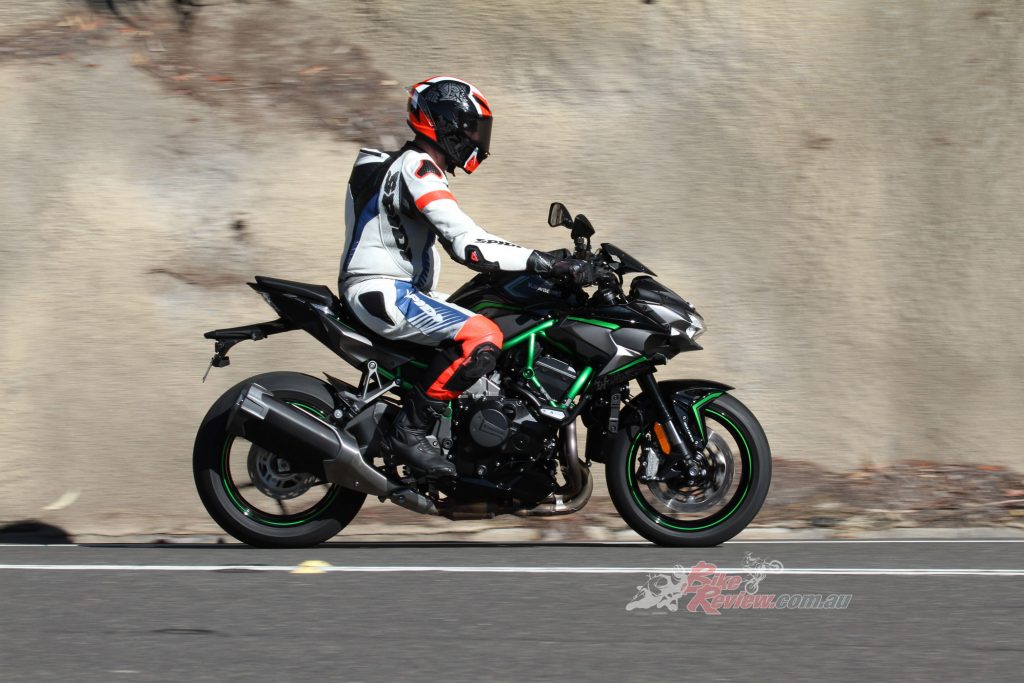
Cruising home. The Z H2 is smooth and easy going when you want it to be. A relaxed ride. With a wild side, of course.
That top heavy bias is only an issue in the stop/start traffic and at low speed. Once on the move it isn’t an issue at all. A quick chat to Jack, who is on the Vulcan SE, at the next set of lights reveals that the Z sounds awesome from the outside, better than the other supercharged models from Kawasaki. I check video later in the week and this is true, the Z H2 supercharger is pretty loud in ride by footage. It’s fun in town, the clutch is smooth, the gearbox is a firm shift and needs clutch under 2500/3000rpm but the quickshifter (up/down) is spot on after that range, and the bike certainly attracts attention.
Finally out of town, I take the back way rather than the freeway. Plenty of cops around thanks to COVID-19, plus I’m a stand out on this thing in full leathers, on a popular bike road, so I cruise through. Listening to the SC sounds bouncing off the sandstone walls is so cool. It’s a fun experience and ride, even at slow speeds. The Z is comfy, soft, and I fit it well at 187cm. The tank area is wide, the ‘bars a good reach and the levers are well positioned. It is comfortable enough for a long day…
I exit and jump on the freeway for a 22km test out, I want to try the cruise control and see how smooth that motor is while slabbing it. The great thing is it easily accessible on the left switch block. Locking in 110km/h in top, the Z sits on around 4,800-5000rpm and is as smooth as the best touring bikes out there. The huge frontal area, the closest thing to a fairing without being a fairing, offers good protection from the elements. There is minimal wind blast and even some leg protection. The soft rear shock makes these transport miles comfy. The cruise control is fantastic. A pleasant ride.
Everything else about the bike is good. The mirrors are small but they remain clear. The TFT dash, like the rest of the Kawasaki premium family, is brilliant and packed with features. The menu and Ride Modes are easy to navigate. The brakes are great, even in the suburbs, with good feel and ample power from the mid-spec Brembo M4.32 calipers. The rotors are 320mm, so smaller than the other supercharged model 330mm items. The calipers are also a step back, however, this makes for easier, more controlled braking around town, while still giving plenty when pushing hard. The rear brake, though, hardly works at all on our bike. It’s a shame as the Z desperately needs rear brake to help it.
Even at my mild pace and with this highway cruising, the Z is still consuming premium unleaded at a rapid rate. With a 19L fuel tank capacity, expect to get a maximum of 230km out of say 17L of that. Open up the taps though, and you will be looking for fuel at 120km. But if fuel consumption is an issue, a 200hp supercharged supernaked is probably not the choice of two wheels for you.
Speaking of fuelling, this is an aggressive bike so as the power comes in, it is quite abrupt and explosive anyway. It is a bit hard to say if the fuelling is good in that area or not, however, in the lower speeds and in the closed to open throttle area, there is some abruptness. I would not go as far as saying there is throttle snatch, however, it could be a little smoother. The H2 and H2 SX SE have the same feel there. I’d be interested to ride one that has been custom mapped.
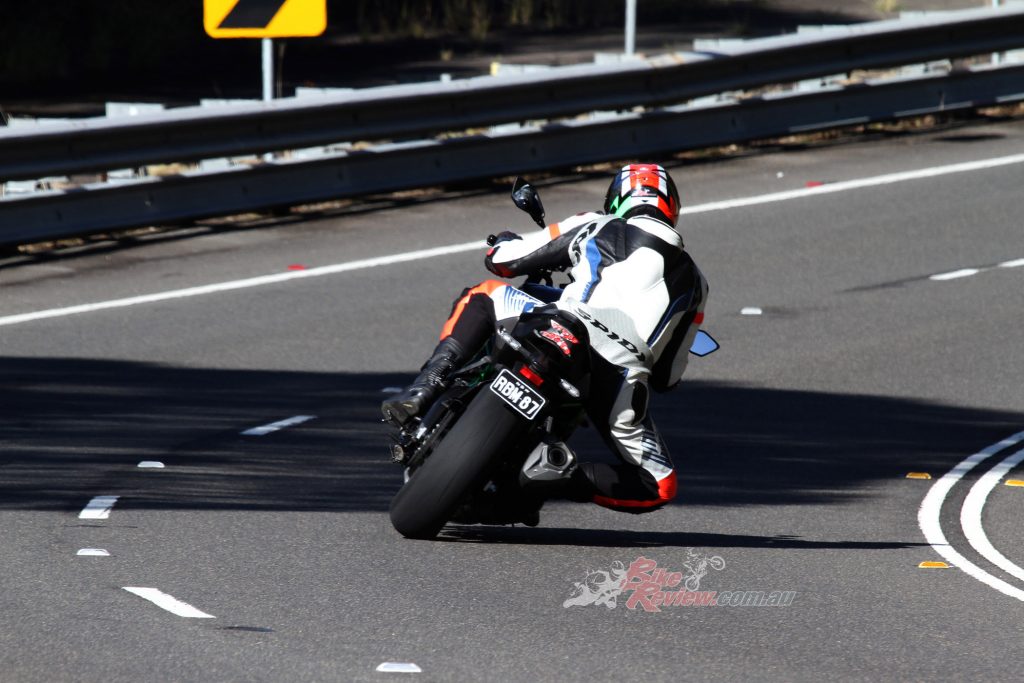
After a few days using the Z H2 as a daily ride, which it did exceptionally well, I headed out for a play in the hills.
By the time I arrive home, I’m more than impressed with most aspects of the Z H2. It regulates temperature well, doesn’t cook your legs, is mild mannered around town but mental once on full boost. I use it for a few days as my daily, then decide to head out for a proper test loop up in the hills on a 300km loop of smooth, bumpy, tight, flowing, just about everything roads…
I had concerns about the Showa rear shock on my ride home from Kawasaki but decided to wait until I got home to check the settings. I grab the tools and check both ends. Damn. They are spot on standard. The forks are on the harsher side of damping, the shock is underdamped big time. I was hoping I could sort it out. It only has rebound and preload at the back. The preload is already very minimal and any more would cause even less rebound control. I set the rebound to just 1/4 turn out, hoping for the best, but even with the shock cold, the control is lacking. It’s a major problem.
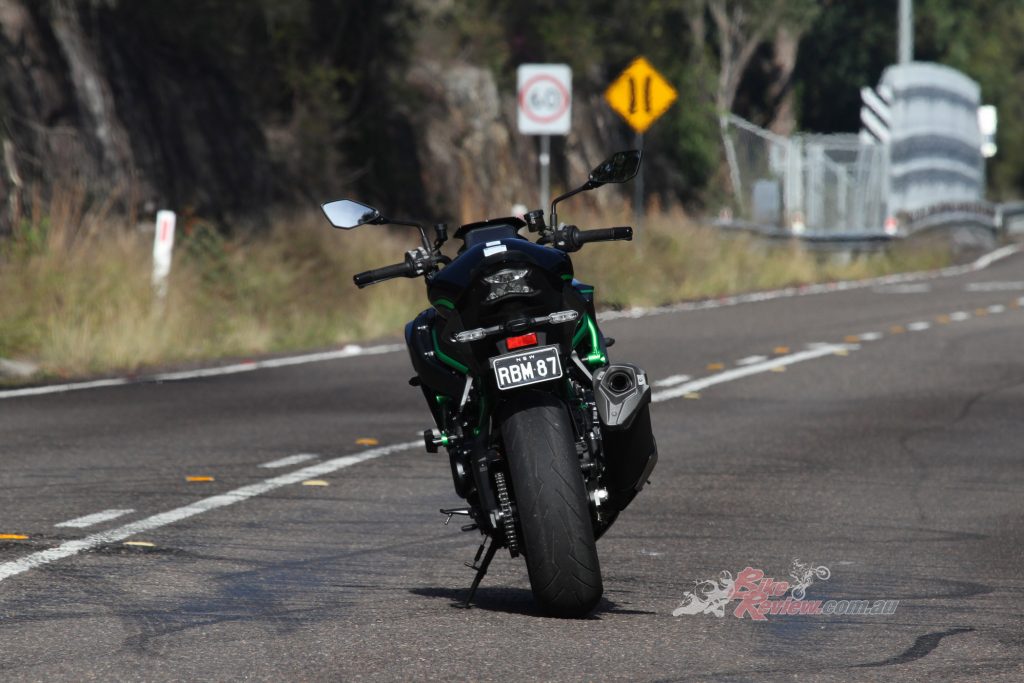
Everything about the Z H2 is awesome, except the rear suspension. Buy a decent shock and have it fitted at the first service and you have yourself a weapon. Kawasaki chose the wrong area to keep costs down this time.
I select Road Mode and head off for the day. Once out of town I switch to Sport and get going. The engine is insane. I know I have said it but even though there are more powerful bikes out there, the way the Z H2 delivers the power is amazing. It feels quicker than the H2 and a lot quicker than the SX SE. Sport gives full power, an aggressive throttle response and wheelie mitigation. It is a bit intrusive in the presets and upsets the already wobbly handling, so I end up switching to Rider Mode, full power with traction on 1, the least intrusive that still controls wheelstands, but the front still lifts what feels like a foot or so in the air. It means I can get on with hard charging and not worry about flipping it!
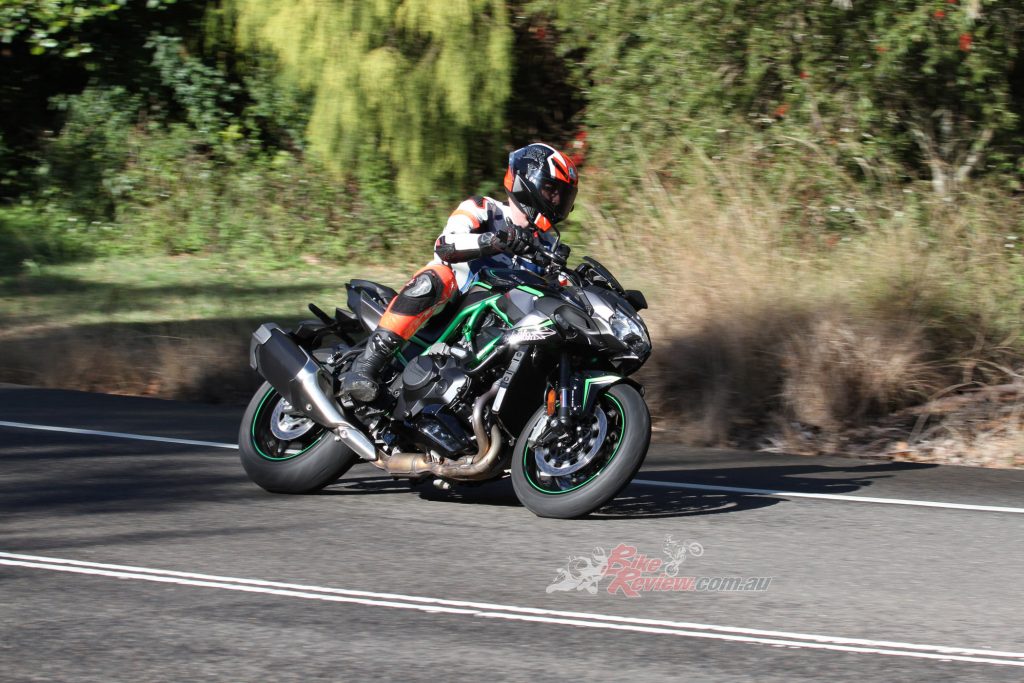
Rider Mode, full power and KTRC on level 1 seemed to be the best option for hard charging on the Z H2.
Back to the rear suspension. I’m an experienced rider and racer and for me, controlling the Z H2 and keeping it on line, or even on the road at times, is difficult at any pace above 6/10ths. The rear, as soon as it is hot, lacks rebound control. It is under sprung and I reckon it has a linkage ratio issue as well. I tried as deep as 1/8th out on rebound and that didn’t help (it’d just overheat the oil more anyway). What happens when the rear is out of control? The front is too. The Z H2 runs wide, you only need to breath on the throttle and it is standing up and running wide. The forks themselves are top spec KYB SFF-BP items, so with a decent shock, the Z H2 would be well specced in the suspension area.
Mid corner bumps make the machine wobble. It is a shame as it tarnished an otherwise amazing motorcycling experience up until that point for me. In the end, I had to back off, go back to Road Mode and spend the rest of the day riding with caution at a very reserved pace. I really can’t finish my test as I would normally have a lot more feedback for you on steering, braking, geometry, fast and slow corners and lots more, however, I will have to wait until we can re-test the Z H2. I was unable to take the bike to the limits I normally would to cover my usual test points.
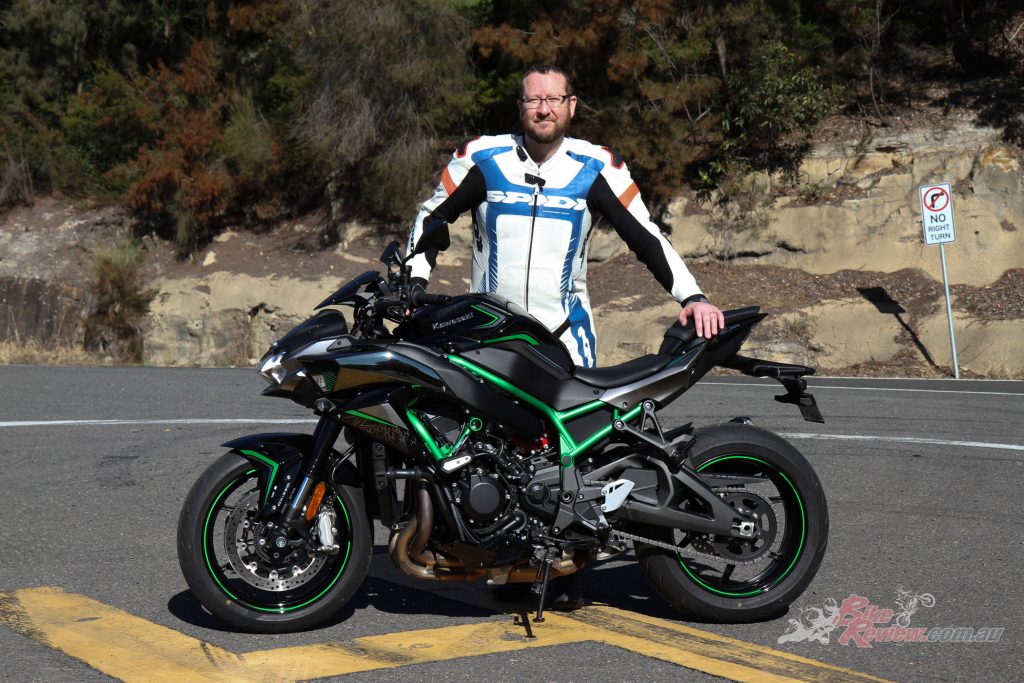
The Z H2. A bike Jeff loved enough to say he wants to buy one yet a bike that needs the shock replaced from new…
CONCLUSION
In the end, as the day progressed, I still enjoyed the machine but there was no hiding from the fact it needs sorting at the back. Would the handling be a deal breaker? Not for me. At $23k I think it is a bargain and I’d happily spend another grand or $1500 on a shock. I don’t think anyone will be able to live with the standard shock, it is that bad.
The positives of the Z H2, for me, make the bike a very special beast indeed and I’d just fix the suspension. However, I’m from the 1990s era when most bikes rolled off the showroom then got a shock at the first service. Other customers may expect more these days and rightly so. I’d imagine the next model Z H2 will have a better set-up. I can’t wait to ride one that is sorted and I hassled Kawasaki to do it when I returned the bike. Stay tuned…
TECH TALK
ENGINE
The Electronic Throttle Valves and FI settings are the prime contributors in helping the massively powerful supercharged engine have easy-to-control character. In addition, short final gearing and optimised valve timing help realise smooth acceleration at low-mid rpm, and longer header pipes in the chamberless exhaust system further contribute to low-mid range performance.
Like on the Ninja H2, high supercharger efficiency means that an intercooler is not required. Although automotive engines with superchargers typically have separate lubrication systems, but Kawasaki’s supercharged engines use a single lubrication system to provide cooling oil for the engine components, supercharger and transmission. This allows the elimination of duplicate parts like oil pumps, contributing to weight reduction.
One of the keys to achieving the Z H2’s power is its ø69mm impeller. Formed from a forged aluminium block using a 5-axis CNC machining centre, its complex shape features 6 blades at the tip, expanding to 12 blades at the base. Interestingly, cast pistons are used. The cylinders use a dummy head during the honing process, which allows low-tension piston rings that help minimise mechanical loss. Using a composite manufacturing method, the exhaust valves are made of two types of metals: an inconel material with excellent heat resistance and heat-resistant steel.
The plenum chamber is made of alloy and is able to handle the supercharged air pressure (approximately 2 atm). A diffuser and net located at the intake chamber inlet help to smooth intake airflow, and contributes to overall supercharger efficiency, which helps prevent engine knocking. The frontal area of the Ram Air intake is about three times the area of the supercharger entrance.
Electronic Throttle Valves enable the ECU to control the volume of both the fuel and the air delivered to the engine. The system also contributes to reduced emissions. Further, being able to control intake air also enables more precise control of KTRC (Kawasaki Traction Control).
Oil jets lubricate the supercharger chain at the contact points (two places) where the chain meets the upper and lower gears. In addition to the two oil jets, the supercharger drive train’s lower gear has an oil passage. Inside the engine, each of the four pistons has a dedicated oil jet. Transmission oil jets enable a compact transmission with high durability.
In addition, a liquid-cooled oil cooler helps to ensure the cooling performance. The large, curved radiator flows a large volume of air aided in part by the design of the radiator shrouds, which help to discharge the heated air. As a result, in spite of the high engine output of 200PS, only one radiator fan is needed, which also contributes to weight reduction.
Developed based on feedback from the Kawasaki Racing Team, the dog-ring transmission has a special structure where the gears all stay in place. Only the dog rings move, sliding into position to engage the desired gear. Since the dog rings are much lighter in weight than the gears, the shifting effort is lighter and the shift touch is also good, enabling a shorter shift time.
CHASSIS
The trellis frame combines pipes of high-tensile steel, each with carefully selected diameter, thickness and bend to obtain the necessary stiffness for that part of the frame.
The Swingarm Mounting Plate is fastened to the back of the engine, with the swingarm pivot shaft passing through, essentially allowing the swingarm to be mounted directly to the engine. In addition, the Swingarm Mounting Plate acts as a cross member in the frame. The engine is mounted at an almost upright angle, contributing to the optimised position for the bike’s centre of gravity.
For this model, SHOWA’s SFF-BP front fork is used. The fork’s large-diameter piston provides firm bottoming resistance and sporty damping characteristics. Adjustable preload and damping allow riders to easily set up the bike according to their size and the riding conditions. New Uni Trak rear suspension and swingarm feature a basic SHOWA shock absorber unit and ZX-10R style swingarm.
The front brakes are gripped by Brembo M4.32 monobloc calipers. Machined from cast aluminium blocks, their highly rigid one-piece structures boast strong braking force. The calipers are radially mounted. The Nissin master-cylinder, fine-tuned with Kawasaki original settings.
ELECTRONICS
Integrated Riding Modes:
Sport, Road, Rain, Rider (Manual)
All-inclusive modes that link KTRC and Power Mode allow riders to efficiently set traction control and power delivery to suit a given riding situation. Riders can choose from three settings (Sport, Road, Rain) or a manual setting (Rider). In the manual Rider mode, each of the systems can be set independently.
Enhanced Chassis Orientation Awareness:
IMU enables inertia along 6 DOF (degrees of freedom) to be monitored. Acceleration along longitudinal, transverse and vertical axes, plus roll rate and pitch rate are measured. The yaw rate is calculated by the ECU using Kawasaki original software.
In addition to more precise management, feedback from the IMU enables KIBS to incorporate an additional function. Corner braking management assists riders in tracing their intended line through the corner. Bosch’s latest IMU is highly compact and very lightweight, weighing only 40g.
KTRC (Kawasaki Traction Control)
Riders can choose from three modes. Mode 1 prioritises forward acceleration. Mode 2 offers a balance between acceleration performance and rider reassurance. Mode 3 provides rider reassurance by facilitating smooth riding on slippery surfaces. Riders may also elect to turn the system off.
KCMF (Kawasaki Cornering Management Function)
Using the latest evolution of Kawasaki’s advanced modelling software and feedback from a compact Bosch IMU (Inertial Measurement Unit), KCMF monitors engine and chassis parameters throughout the corner – from entry, through the apex, to corner exit – modulating brake force and engine power to facilitate smooth transition from acceleration to braking and back again and to assist riders in tracing their intended line through the corner.
KIBS (Kawasaki Intelligent anti-lock Brake System)
KIBS, Kawasaki’s original brake management system, uses high-precision control to regulate hydraulic brake pressure. During sports riding, it provides linear braking characteristics, enabling effective and stable braking with minimal intervention. When the brakes are applied while turning, KIBS’ highly advanced hydraulic control is used to modulate brake force to assist riders trace their intended line through the corner.
KLCM (Kawasaki Launch Control Mode)
Designed to assist the rider by optimising acceleration from a stop, KLCM electronically manages engine output to minimise wheelspin and wheel lift when launching.
KAWASAKI RIDEOLOGY App USER VIDEO
KQS (Kawasaki Quick Shifter)
Above 2500rpm, KQS enables clutchless upshifts and downshifts. Complementing the powerful engine and dog-ring transmission, the quickshifter It enables quick upshifts and downshifts, facilitating smooth acceleration and deceleration.
Electronic Cruise Control
Kawasaki’s cruise control system allows a desired speed to be maintained with the simple press of a button. Operation of the Electronic Cruise Control is conveniently activated from the left handle. Once the desired speed has been selected, engine output is adjusted automatically via the Electronic Throttle Valves to maintain speed when ascending or descending grades are encountered.
TFT Instrument Panel
Display functions include a digital speedometer, gear position indicator, shift indicator, odometer, dual trip meters, fuel gauge, remaining range, current/average fuel consumption, outside temperature, coolant temperature, clock, Economical Riding Indicator, IMU indicator, KIBS indicator, boost pressure and boost temperature.
Smartphone Connectivity
In addition to checking machine information and recording and downloading logs, settings such as Riding Mode can be prepared remotely. A Bluetooth chip built into the instrument panel enables riders to connect to their motorcycle wirelessly. Using the smartphone application RIDEOLOGY THE APP a number of instrument functions can be accessed.
2020 Kawasaki Z H2 SPECIFICATIONS
Price & Availability: $23,000 + ORC ($25,542 R/A Sydney 2000)
Click here and enter your postcode for a R/A price.
Colours: Metallic Spark Black/Black Graphite Grey/Mirror Coated Spark Black
Claimed power: 147kW(200hp)@11,000rpm
Claimed torque: 137Nm(101ft-lbs)
Weight: 239kg
Fuel capacity: 19L
Engine: Liquid-cooled, DOHC, 16v, inline four-cylinder four-stroke, supercharged, 998cc|
Gearbox: Six speed, constant mesh, sliding dog-ring
Clutch: Wet multi-disc, slipper
Final drive: Chain
Chassis: High tensile steel trellis frame, Rake: 24.9°, Trail: 104mm
Suspension: KYB SFF-BP forks, 120mm travel, Showa shock (comp and rebound adj), 134mm travel
Brakes: Brembo M4.32 calipers, 290mm rotor size, 226mm rotor, N/A caliper rear brakes
Wheels & Tyres: Cast alloy 3.50 x 17in (f), 6.00 x 17 (r), 120/70-17in, 190/55-17 tyres
DIMENSIONS:
Wheelbase: 1455mm
Ground clearance: 140mm
Seat height: 830mm
Overall height: 1130mm
Overall length: 2085mm
Overall width: 810mm
Instruments: Full digital multi-function TFT display
The Verdict | Review: 2020 Kawasaki Z H2 Supercharged Nakedbike

